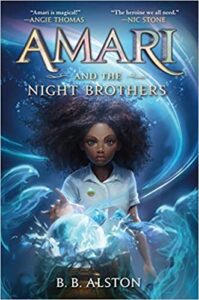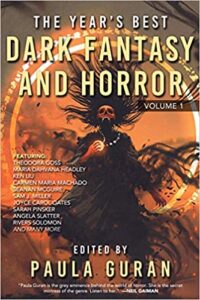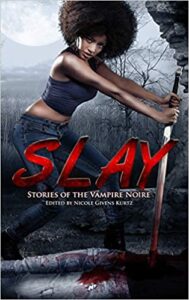 ( Bookshop.org | Amazon.com )
( Bookshop.org | Amazon.com )
Amari and the Night Brothers (Supernatural Investigations #1) by B.B. Alston
Balzer + Bray, 2021
ISBN-13 : 978-0062975164
Available: Hardcover, Kindle edition, audiobook
Thirteen year old Amari Peters has some big footsteps to fill: her older brother Quinton was the highest performing student at ritzy Jefferson Academy. Since his disappearance (or possibly death) six months ago, Amari’s grades, and behavior, are slipping, and on the last day of school, she shoves a mean girl who makes a dig about her brother and loses her scholarship, her best opportunity to get out of the Rosewood Projects and go to college. Grounded indefinitely, Amari hasn’t been home long when the doorbell rings and she’s asked to sign for a package that, oddly, has been delivered to Quinton’s closet. Opening the package, Amari discovers she has been nominated by her missing brother for a scholarship to the Bureau of Supernatural Affairs training camp. The Bureau of Supernatural Affairs keeps supernatural creatures secret while also protecting innocent humans. Quinton and his partner, “special agents” for the Bureau, have gone missing from the Bureau as well, and Amari decides to attend the camp in hopes of discovering what happened to her brother.
Early on, Amari is discovered to have tremendous magical potential, but this turns out to be a major problem when her supernatural power is discovered to be magic, as magicians are universally considered bad and magic is illegal. Among a throng of privileged “legacy” trainees, Amari’s race, socioeconomic status, and illegal magic make her a pariah among the other trainees, and more determined than ever to qualify to become a Junior Agent and find the answers that will lead to her brother.
While individual elements of the story may sound familiar (a mysterious letter, a summer camp for teenage legacies, mythical and supernatural creatures hidden in plain view, and evil magicians all show up in either Harry Potter or Percy Jackson) B.B. Alston has mixed them up to create something very different. A big piece of that is that Amari, a smart and determined Black girl who already has to prove herself in the outside world, is the point of view character, so we get to see a resourceful character working hard who keeps going even when she’s discouraged by hostility and racism. Nobody hands her a destiny or quest to fulfil, does her homework for her, or makes decisions for her, although she occasionally gets a boost of encouragment from a friend. Alston is also incredibly creative in his world-building (talking elevators with individual personalites, delightful and spooky departmental names and descriptions, gorgeously described magical illusions, magic that can manipulate technology, gossip rags that give you juicy tidbits only when you ask the right questions, and so much more).
Although there are some terrifying creatures and spells, the scariest parts of the book really involve the people who interact with Amari: spoiled mean girl Lara van Helsing, who spreads nasty rumors; evil magician Raoul Moreau, one of the “Night Brothers”; racist kids who draw malicious graffiti on the walls of Amari’s bedroom; Bureau directors certain Amari is a danger to the supernatural world. Amari and the Night Brothers is more of a dark urban fantasy and coming-of-age story than it is a horror story, but it is a great #OwnVoices title that provides a fresh point of view in a genre that seems to be telling the same story over again and again. I’m looking forward to book #2. Highly recommended for grades 4-8






Follow Us!